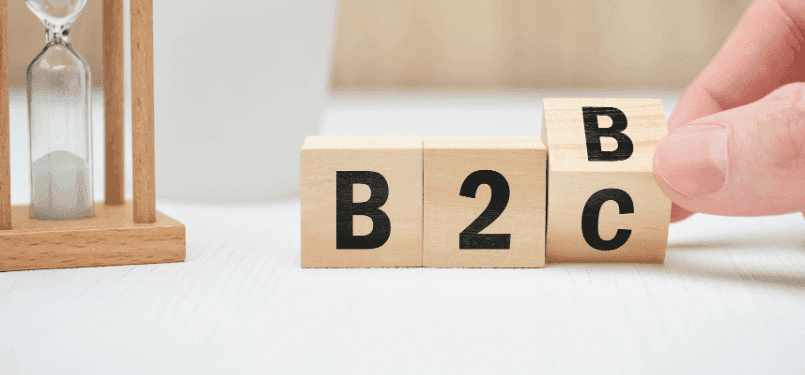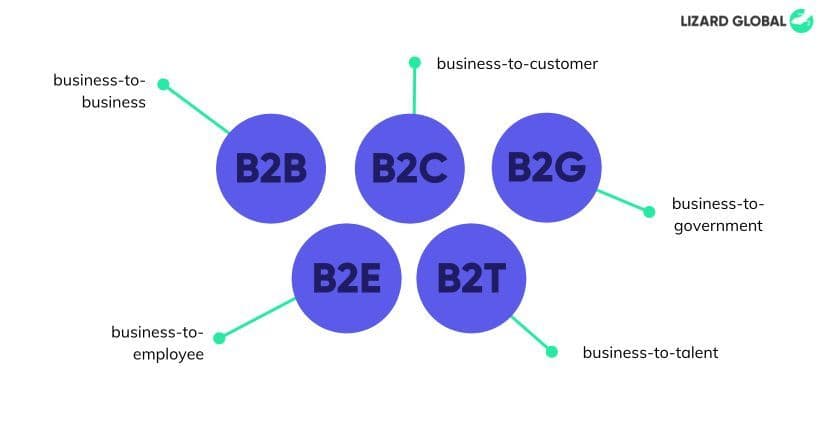app development
b2b
+ 9 more ...
B-to-what? The crucial differences between B2B and B2C Applications
14 Dec 2023
by Lotte, Digital Content Specialist & Asrul Ash
14 Dec 2023
by Lotte, Digital Content Specialist & Asrul Ash
app development
b2b
b2c
mobile app
web app
app store
enterprise software
business software
consumer software
government software
talent recruiting
B-to-what? The crucial differences between B2B and B2C Applications
Table of contents
Contact us
We will get back to you in the next 48 hours.

B-to-what_ The crucial differences between B2B and B2C Applications
There are major differences between B2B and B2C business models that can greatly impact the functionality and marketing of an application.
Follow Lizard Global on Facebook, Instagram, and LinkedIn.
There are countless different types of applications launching every day. From mobile apps to progressive web applications, and from gaming apps to productivity tools. The purpose of an application and its target audience has a major impact on the functionalities and features it possesses. In our blog on the price of app development, you could already read about the differences between a B2B and a B2C app, and the effect these differences have on the development price. In this blog, we dive a little deeper into the topic of B2B and B2C applications and business models, as well as B2G and B2T. Already getting lost? Don’t worry, this article explains it all.
Curious About the Cost of Your Dream App? Let's Crunch Numbers Together!
We get it, pricing can be a puzzler. But fear not! Our App Cost Estimator tool is here to sprinkle a bit of magic on your budgeting journey. It's as easy as picking your features and voilà—your app investment laid out in front of you. Click, calculate, and get ready for the appventure of a lifetime.
Want to find out how much it costs to build your dream app or web app?
B-to-what?
Before we dive into the different types of business models and applications, it’s good to clarify what it means to be a B2-something firm or product. In simple terms, “B2” stands for “Business-to-..”. This suggests an exchange or dynamic between two parties. Such as a business and a consumer (B2C), or a business to a business (B2B), and more examples we dive into later on.
This exchange between two parties usually involves a party who provides a product or service and a party who receives and makes use of the product, or in this case, an application. In other words, the first party is the provider of a good or service, and the second part consists of the consumer of said good or service. Depending on who this target audience consists of, the business model, marketing strategies, and products/services of the providing firm can greatly differ. How that works exactly, we’ll explain below by pulling each model apart.
B2B: Business to Business
Business-to-business (B2B), usually referred to as B2B, is a type of exchange that occurs between two or more businesses, such as between a manufacturer and a wholesaler, or between a wholesaler and a retailer. Simply said, B2B refers to exchanges that take place between businesses rather than between businesses and individual customers, as is the case with B2C.
Firms implement and use B2B applications to communicate with other businesses, clients, or internal staff and optimize internal and external business processes. Some B2B apps are open to the public, while others are only utilized internally within one specific company or a few companies within the same industry. Many of the apps in this category are enterprise apps that are built to meet a specific purpose, such as in-house inventory management or data analytics and management portal.
B2E: Business to Employee
A side-branch of the B2B model consists of the business-to-employee model or B2E model. B2E applications usually consist of an educational, informative, or centralized dashboard tool to help employees within the company improve their productivity, skill sets, and overall working experience. It can often be defined as an HR tool to ensure employees are aligned with the organizational objectives of the company. While few companies actually develop an application that is only used by their own employees, most of these applications are also externally available for other businesses looking for a way to align their employees with organizational goals.
Did you know that Lizard Global has its own B2E solution? Our application GrowTribe consists of a growth tracker and performance tracker, to keep employees aligned with organizational goals. Curious? Check out the case study here.
B2B Benefits
One of the key reasons why businesses choose B2B apps is that they provide more scalability and a structured environment. Because these apps are usually designed to handle a very specific problem, you'll notice that the approach they use is rather simple. As a result, the purpose of such apps is clearly stated, which means that an iOS or Android developer knows exactly what the app's key objectives and goals are, making their job much easier. B2B apps can, for example, lower the cost of overall project and order management. It can also assist organizations in increasing customer satisfaction and loyalty by allowing them to provide a consistent client experience.
B2C: Business to Consumer
A B2C service or product focuses on a target audience consisting of external and individual consumers like you and me. A B2C firm facilitates the purchase of commodities, products, and services, speaking to widespread audience segments. Examples of B2C applications are eCommerce apps, which are ideal for retailers looking to establish an online presence for their products. For us as users, it’s much easier to scroll through the app of our favorite clothing brand and order products within a few clicks. B2C apps are designed to make users' lives easier and to assist them in completing a task with minimal effort.
Because B2C mobile apps are aimed at a broader audience, they tend to place a greater emphasis on improving the user experience. To keep consumers engaged, they offer functionality in an iterative manner. To keep consumers interested, businesses can use push notifications, provide alerts, display product adverts, and promote offers and discounts. As a result, they are more likely to gain popularity and go viral.
Another advantage of the B2C app is that it allows you to provide 24-hour client service and real-time information for your customers. You can respond to consumer inquiries in a timely and satisfactory manner and assist them in resolving their issues. This aids in the development of long-term consumer relationships. Furthermore, it can assist your organization in generating more income by allowing you to not only attract new consumers but also retain existing ones.
B2T: Business-to-Talent
B2T, or business-to-talent, is all about talent acquisition for companies in all kinds of industries. The B2T model usually doesn’t include a specific application focused on a specific audience segment. Rather, it takes the form of a specific (marketing) strategy within a B2C model/product or B2B model/product. B2T is organized in such a way that it speaks to the right people and knows how to trigger their interest in an open position or function within a company.

B2G: Business-to-Government
Business to government (B2G) refers to a company selling goods or services to federal, state, or municipal governments. It is one of the most difficult sectors to serve, yet this difficulty also represents an opportunity. In the B2G model, a company sells its product to fulfill the needs of a certain government agency. This is usually accomplished through a well-organized online bidding procedure that can be extremely competitive and bureaucratic. A company that wants to develop products for government agencies must have a well-defined go-to-market plan.
An example of B2G can be a small business offering basic IT services to a local government, but it can also be as large as Boeing, which manufactures helicopters, missile defense systems, fighter jets, and surveillance aircraft for the United States Department of Defense, among other things. When working with government agencies, firms that are normally used to interacting with other businesses or directly with consumers frequently face unanticipated challenges. Governments typically take longer than private enterprises to authorize and start off a development project. Additionally, flexibility in functionality, design and tech stack efficiencies may also be hindered due to regulation and procedures.
B2B vs. B2C Marketing strategies
The ways in which B2B and B2C apps recruit users are vastly different. App stores, and occasionally digital marketing on social media platforms like Facebook and Instagram, are the primary sources of B2C app discovery. Word of mouth from consumers' family and friends also plays a part, albeit a minor one. App store optimization, user reviews, star ratings, and social media buzz all play a role in enhancing your B2C app's discovery. To get the word out and attract consumers to your app, you can employ Social Media advertising, YouTube ads, or even TV ads. The goal is to get as much exposure as possible. The most important aspect of B2C marketing is getting a huge number of individual users; the more the better.
B2B product marketing revolves around a company whose major customer is another company, rather than ordinary customers, as is the case with B2C. And, because they only advertise their products, services, or solutions to other businesses, B2B marketers focus most of their marketing efforts on individuals or teams who make purchasing choices on behalf of their organizations. They usually do this by advertising their products online targeting specific industries or business segments. Because B2B applications are widely available outside app stores, the marketing of their products or services needs to send their audience to their website, where they can access the product and learn more about the product in order to make a purchasing decision. B2B marketing also heavily relies on word of mouth marketing, in which the product or service gets recommended to other businesses who struggle with similar problems.
🔥 Looking for the fastest way to calculate app development costs? Get a realistic estimate of your web & mobile app development project with our App Cost Estimator. Totally FREE! Click, calculate, and get ready for the appventure of a lifetime.
Why your business model matters in app development
It's critical to know what kind of app you need, as this will influence the specifications of the application you are planning to build and with that the selection of your development partner. You must decide whether you will release the app to a select group of people (like with B2B apps) or to the broader public (as is the case with most B2C apps). If you choose the latter, you'll get the best results by submitting your app to one or both app stores, depending on the platform you develop your app for.
If you're not sure whether you should submit your application to the Google Play Store or the Apple App Store, have a look at this blog or get in touch with our experts.
How does the sales process vary between B2B and B2C applications?
The sales processes for B2B (Business-to-Business) and B2C (Business-to-Consumer) applications exhibit distinct characteristics, reflecting the unique nature of their target audiences and business objectives.
In the realm of B2B applications, the sales cycle is known for its intricacy and duration. Unlike the more straightforward B2C sales approach, B2B transactions often involve a prolonged series of negotiations, approvals, and customization processes. Business-to-business deals are not sealed overnight; they require careful consideration and discussion to ensure alignment with the specific needs and objectives of the business clients. This extended sales cycle is a reflection of the complexity inherent in catering to organizational requirements, where decision-making involves multiple stakeholders and thorough assessments.
Conversely, the B2C sales process is characterized by its simplicity and directness. B2C applications focus on reaching individual consumers with a more immediate need for products or services. The sales cycle tends to be shorter, emphasizing quick and efficient transactions. In the B2C landscape, the key priority is often customer satisfaction, with the goal of delivering a seamless and enjoyable buying experience. The emphasis on speed and simplicity is driven by the individual nature of B2C transactions, where personal preferences and immediate needs play a more prominent role.
How do B2B and B2C applications handle pricing models?
In the context of B2B applications, pricing models are tailored to accommodate the complexity of business relationships. Negotiated pricing takes center stage, allowing for discussions and agreements that align with the unique requirements of each business client. Bulk discounts are common, encouraging businesses to make larger purchases, and custom quotes based on specific needs provide flexibility in catering to diverse enterprises. The B2B pricing landscape recognizes the diversity of businesses and aims to offer solutions that are both competitive and customized.
On the flip side, B2C applications adopt a more straightforward approach to pricing. Fixed pricing is a standard practice, providing clarity to individual consumers about the cost of products or services. Discounts and promotional strategies are often employed to attract and retain customers in the highly competitive B2C market. The emphasis here is on transparency and accessibility, making it easier for consumers to make purchasing decisions without the need for extensive negotiations or customizations.
Need a hand?
If you need assistance conceptualizing, designing, developing, and marketing a B2B, B2C, B2G, B2E, or any other type of application for your business, the experienced team of Lizard GLobal is always more than happy to help. We specialize in all aspects of app design and development, including idea conceptualization, UI/UX design, MERN programming, usability testing, MVP delivery, all packed in an agile scrum and design thinking approach.
We are specialized in providing our services digitally, and we’re active on a global scale with clients from all over the world. So, no matter where you are, we’re here to lend you a hand in the development of your unique digital solution. Get in touch with us via our social media channels, mail, and contact form, give us a call or send a quick message on WhatsApp for more info.

Curious About the Cost of Your Dream App? Let's Crunch Numbers Together!
We get it, pricing can be a puzzler. But fear not! Our App Cost Estimator tool is here to sprinkle a bit of magic on your budgeting journey. It's as easy as picking your features and voilà—your app investment laid out in front of you. Click, calculate, and get ready for the appventure of a lifetime.
Want to find out how much it costs to build your dream app or web app?

B-to-what_ The crucial differences between B2B and B2C Applications
There are major differences between B2B and B2C business models that can greatly impact the functionality and marketing of an application.
Follow Lizard Global on Facebook, Instagram, and LinkedIn.
There are countless different types of applications launching every day. From mobile apps to progressive web applications, and from gaming apps to productivity tools. The purpose of an application and its target audience has a major impact on the functionalities and features it possesses. In our blog on the price of app development, you could already read about the differences between a B2B and a B2C app, and the effect these differences have on the development price. In this blog, we dive a little deeper into the topic of B2B and B2C applications and business models, as well as B2G and B2T. Already getting lost? Don’t worry, this article explains it all.
Curious About the Cost of Your Dream App? Let's Crunch Numbers Together!
We get it, pricing can be a puzzler. But fear not! Our App Cost Estimator tool is here to sprinkle a bit of magic on your budgeting journey. It's as easy as picking your features and voilà—your app investment laid out in front of you. Click, calculate, and get ready for the appventure of a lifetime.
Want to find out how much it costs to build your dream app or web app?
B-to-what?
Before we dive into the different types of business models and applications, it’s good to clarify what it means to be a B2-something firm or product. In simple terms, “B2” stands for “Business-to-..”. This suggests an exchange or dynamic between two parties. Such as a business and a consumer (B2C), or a business to a business (B2B), and more examples we dive into later on.
This exchange between two parties usually involves a party who provides a product or service and a party who receives and makes use of the product, or in this case, an application. In other words, the first party is the provider of a good or service, and the second part consists of the consumer of said good or service. Depending on who this target audience consists of, the business model, marketing strategies, and products/services of the providing firm can greatly differ. How that works exactly, we’ll explain below by pulling each model apart.
B2B: Business to Business
Business-to-business (B2B), usually referred to as B2B, is a type of exchange that occurs between two or more businesses, such as between a manufacturer and a wholesaler, or between a wholesaler and a retailer. Simply said, B2B refers to exchanges that take place between businesses rather than between businesses and individual customers, as is the case with B2C.
Firms implement and use B2B applications to communicate with other businesses, clients, or internal staff and optimize internal and external business processes. Some B2B apps are open to the public, while others are only utilized internally within one specific company or a few companies within the same industry. Many of the apps in this category are enterprise apps that are built to meet a specific purpose, such as in-house inventory management or data analytics and management portal.
B2E: Business to Employee
A side-branch of the B2B model consists of the business-to-employee model or B2E model. B2E applications usually consist of an educational, informative, or centralized dashboard tool to help employees within the company improve their productivity, skill sets, and overall working experience. It can often be defined as an HR tool to ensure employees are aligned with the organizational objectives of the company. While few companies actually develop an application that is only used by their own employees, most of these applications are also externally available for other businesses looking for a way to align their employees with organizational goals.
Did you know that Lizard Global has its own B2E solution? Our application GrowTribe consists of a growth tracker and performance tracker, to keep employees aligned with organizational goals. Curious? Check out the case study here.
B2B Benefits
One of the key reasons why businesses choose B2B apps is that they provide more scalability and a structured environment. Because these apps are usually designed to handle a very specific problem, you'll notice that the approach they use is rather simple. As a result, the purpose of such apps is clearly stated, which means that an iOS or Android developer knows exactly what the app's key objectives and goals are, making their job much easier. B2B apps can, for example, lower the cost of overall project and order management. It can also assist organizations in increasing customer satisfaction and loyalty by allowing them to provide a consistent client experience.
B2C: Business to Consumer
A B2C service or product focuses on a target audience consisting of external and individual consumers like you and me. A B2C firm facilitates the purchase of commodities, products, and services, speaking to widespread audience segments. Examples of B2C applications are eCommerce apps, which are ideal for retailers looking to establish an online presence for their products. For us as users, it’s much easier to scroll through the app of our favorite clothing brand and order products within a few clicks. B2C apps are designed to make users' lives easier and to assist them in completing a task with minimal effort.
Because B2C mobile apps are aimed at a broader audience, they tend to place a greater emphasis on improving the user experience. To keep consumers engaged, they offer functionality in an iterative manner. To keep consumers interested, businesses can use push notifications, provide alerts, display product adverts, and promote offers and discounts. As a result, they are more likely to gain popularity and go viral.
Another advantage of the B2C app is that it allows you to provide 24-hour client service and real-time information for your customers. You can respond to consumer inquiries in a timely and satisfactory manner and assist them in resolving their issues. This aids in the development of long-term consumer relationships. Furthermore, it can assist your organization in generating more income by allowing you to not only attract new consumers but also retain existing ones.
B2T: Business-to-Talent
B2T, or business-to-talent, is all about talent acquisition for companies in all kinds of industries. The B2T model usually doesn’t include a specific application focused on a specific audience segment. Rather, it takes the form of a specific (marketing) strategy within a B2C model/product or B2B model/product. B2T is organized in such a way that it speaks to the right people and knows how to trigger their interest in an open position or function within a company.

B2G: Business-to-Government
Business to government (B2G) refers to a company selling goods or services to federal, state, or municipal governments. It is one of the most difficult sectors to serve, yet this difficulty also represents an opportunity. In the B2G model, a company sells its product to fulfill the needs of a certain government agency. This is usually accomplished through a well-organized online bidding procedure that can be extremely competitive and bureaucratic. A company that wants to develop products for government agencies must have a well-defined go-to-market plan.
An example of B2G can be a small business offering basic IT services to a local government, but it can also be as large as Boeing, which manufactures helicopters, missile defense systems, fighter jets, and surveillance aircraft for the United States Department of Defense, among other things. When working with government agencies, firms that are normally used to interacting with other businesses or directly with consumers frequently face unanticipated challenges. Governments typically take longer than private enterprises to authorize and start off a development project. Additionally, flexibility in functionality, design and tech stack efficiencies may also be hindered due to regulation and procedures.
B2B vs. B2C Marketing strategies
The ways in which B2B and B2C apps recruit users are vastly different. App stores, and occasionally digital marketing on social media platforms like Facebook and Instagram, are the primary sources of B2C app discovery. Word of mouth from consumers' family and friends also plays a part, albeit a minor one. App store optimization, user reviews, star ratings, and social media buzz all play a role in enhancing your B2C app's discovery. To get the word out and attract consumers to your app, you can employ Social Media advertising, YouTube ads, or even TV ads. The goal is to get as much exposure as possible. The most important aspect of B2C marketing is getting a huge number of individual users; the more the better.
B2B product marketing revolves around a company whose major customer is another company, rather than ordinary customers, as is the case with B2C. And, because they only advertise their products, services, or solutions to other businesses, B2B marketers focus most of their marketing efforts on individuals or teams who make purchasing choices on behalf of their organizations. They usually do this by advertising their products online targeting specific industries or business segments. Because B2B applications are widely available outside app stores, the marketing of their products or services needs to send their audience to their website, where they can access the product and learn more about the product in order to make a purchasing decision. B2B marketing also heavily relies on word of mouth marketing, in which the product or service gets recommended to other businesses who struggle with similar problems.
🔥 Looking for the fastest way to calculate app development costs? Get a realistic estimate of your web & mobile app development project with our App Cost Estimator. Totally FREE! Click, calculate, and get ready for the appventure of a lifetime.
Why your business model matters in app development
It's critical to know what kind of app you need, as this will influence the specifications of the application you are planning to build and with that the selection of your development partner. You must decide whether you will release the app to a select group of people (like with B2B apps) or to the broader public (as is the case with most B2C apps). If you choose the latter, you'll get the best results by submitting your app to one or both app stores, depending on the platform you develop your app for.
If you're not sure whether you should submit your application to the Google Play Store or the Apple App Store, have a look at this blog or get in touch with our experts.
How does the sales process vary between B2B and B2C applications?
The sales processes for B2B (Business-to-Business) and B2C (Business-to-Consumer) applications exhibit distinct characteristics, reflecting the unique nature of their target audiences and business objectives.
In the realm of B2B applications, the sales cycle is known for its intricacy and duration. Unlike the more straightforward B2C sales approach, B2B transactions often involve a prolonged series of negotiations, approvals, and customization processes. Business-to-business deals are not sealed overnight; they require careful consideration and discussion to ensure alignment with the specific needs and objectives of the business clients. This extended sales cycle is a reflection of the complexity inherent in catering to organizational requirements, where decision-making involves multiple stakeholders and thorough assessments.
Conversely, the B2C sales process is characterized by its simplicity and directness. B2C applications focus on reaching individual consumers with a more immediate need for products or services. The sales cycle tends to be shorter, emphasizing quick and efficient transactions. In the B2C landscape, the key priority is often customer satisfaction, with the goal of delivering a seamless and enjoyable buying experience. The emphasis on speed and simplicity is driven by the individual nature of B2C transactions, where personal preferences and immediate needs play a more prominent role.
How do B2B and B2C applications handle pricing models?
In the context of B2B applications, pricing models are tailored to accommodate the complexity of business relationships. Negotiated pricing takes center stage, allowing for discussions and agreements that align with the unique requirements of each business client. Bulk discounts are common, encouraging businesses to make larger purchases, and custom quotes based on specific needs provide flexibility in catering to diverse enterprises. The B2B pricing landscape recognizes the diversity of businesses and aims to offer solutions that are both competitive and customized.
On the flip side, B2C applications adopt a more straightforward approach to pricing. Fixed pricing is a standard practice, providing clarity to individual consumers about the cost of products or services. Discounts and promotional strategies are often employed to attract and retain customers in the highly competitive B2C market. The emphasis here is on transparency and accessibility, making it easier for consumers to make purchasing decisions without the need for extensive negotiations or customizations.
Need a hand?
If you need assistance conceptualizing, designing, developing, and marketing a B2B, B2C, B2G, B2E, or any other type of application for your business, the experienced team of Lizard GLobal is always more than happy to help. We specialize in all aspects of app design and development, including idea conceptualization, UI/UX design, MERN programming, usability testing, MVP delivery, all packed in an agile scrum and design thinking approach.
We are specialized in providing our services digitally, and we’re active on a global scale with clients from all over the world. So, no matter where you are, we’re here to lend you a hand in the development of your unique digital solution. Get in touch with us via our social media channels, mail, and contact form, give us a call or send a quick message on WhatsApp for more info.

Curious About the Cost of Your Dream App? Let's Crunch Numbers Together!
We get it, pricing can be a puzzler. But fear not! Our App Cost Estimator tool is here to sprinkle a bit of magic on your budgeting journey. It's as easy as picking your features and voilà—your app investment laid out in front of you. Click, calculate, and get ready for the appventure of a lifetime.
Want to find out how much it costs to build your dream app or web app?
FAQs

What is a B2B application?
What is a B2C application?
What does B2E mean?
What does B2G mean?
What does B2T mean?
Where can I find a developer for my app?







